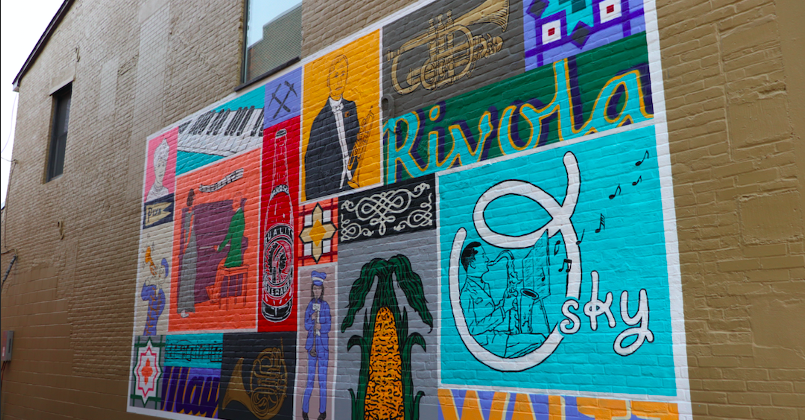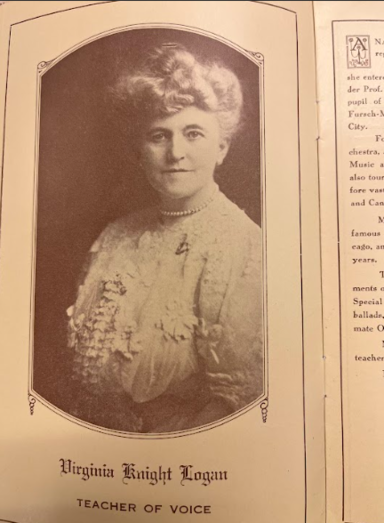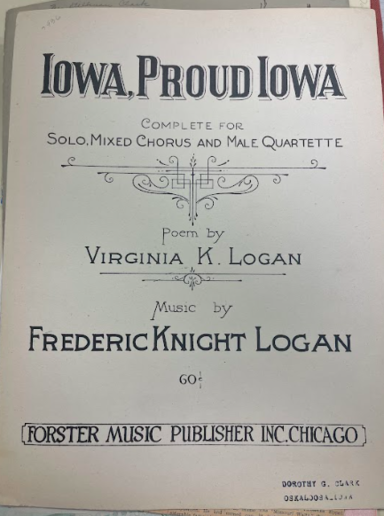On June 21st, 2021, a mural premiered in downtown Oskaloosa, Iowa, that celebrated the rich musical history of the small midwestern town.[1] Notably, one of the largest figures on the mural depicts Virginia Knight Logan singing while her son Frederic Knight Logan accompanies her. While the name of her son may be more familiar because of his popular compositions such as “Missouri Waltz” and “Pale Moon,” this mural dedication demonstrates how Virginia Knight Logan acted as a pillar of the musical life of Oskaloosa who is still remembered to this day, even over 80 years after her death.

Oskaloosa and Iowa remember Logan’s legacy partially due to her involvement with the Iowa General Federation of Women’s Clubs. As a founder of The Oskaloosa Women’s Club, Logan served as president of her local chapter on multiple occasions. Furthermore, she also served on the general federation’s music committee at the state level from 1913-1916, cementing herself as a musical force outside Oskaloosa. Within Oskaloosa, however, Logan employed the role of a musician held in high regard as she frequently performed at funerals, wrote reviews for concerts in the local paper, and co-owned a music business, The Knight-Logan Studio of Musical Art, where she taught lessons in voice. Moreover, she was also known for her poetry and lyrics written for compositions by her son Frederic.
Using archival resources from The Iowa Women’s Archive and The State Historical Society of Iowa, I explore the accomplished history of Virginia Knight Logan and her involvement with music and the women’s club in Oskaloosa. It is important to explore the rich histories of women and women’s clubs, especially within Iowa, to bring to life the stories of those often overlooked for their contributions to Iowa’s music history. Moreover, using these archival sources provides more visibility for future researchers interested in the musical lives of women in Iowa who are often maligned by the focus on Iowa’s male composers and performers. The importance of telling women’s stories cannot be overlooked as it uncovers, excavates, and brings to life a fruitful understanding of the complex sociocultural relationships women have with the worlds in which they reside.[2]
The Women’s Club was an important part of Logan’s role in Oskaloosa. Recognized as one of the founders of the local chapter,[3] Logan was involved with the club for many years, starting in 1887 when she worked with other women to establish the club to apply for a Carnegie Library to be built in Oskaloosa. Logan later served as president on two separate occasions: from May 1912-1913 and again from May 1919-1920.[4] As noted by Wilson Kimber, music played a large role in women’s clubs in Iowa during this time period as it cultivated the development of musical activities at local and state levels.[5] It is thus not surprising that the main source of income for the Oskaloosa women’s club at one point was provided via the royalties from Logan and Frederic’s compositions, suggesting their longtime music philanthropic role within the town and club.[6]
Logan’s role as president was not the only leadership role she occupied as she also served on the music committee for the Iowa General Federation of Women’s Clubs from 1913-1916, speaking to her status as an important musical figure outside of Oskaloosa’s city limits.[7] In this role, she worked at the state level with Iowa clubwomen from different towns to promote the music of Iowa composers, include music and musical topics within women’s club meetings, and organize music-related performances and events at the state level.
In this role, Logan convened at the curious intersection of being a recognized professional musician and clubwoman. In The Torchbearers: Women and Their Amateur Arts Associations in America, 1890-1930, Blair notes that women pursuing arts in women’s clubs were often trapped by societal pressures that were determined to view them as wives and mothers with too many expectations around motherhood and household work limiting their ability to seriously pursue whatever medium they practiced.[8] Logan’s status as a well-known and respected musician in her town challenged the wide-held conception of clubwoman amateurism. This relates deeply to discourses in social reproduction theory that explore how women are impacted by both their gender and agency to generate capital.[9]

Logan was not only a leader in music for women’s clubs, but she was also a musical forerunner for the town of Oskaloosa as an entrepreneur of her music business, The Knight-Logan Studio of Musical Art. This music studio, run out of her own home, was a co-run effort from Logan and Frederic; Logan taught voice lessons while Frederic taught piano lessons.[10] Their business was able to thrive in part due to Logan’s reputation as a touring soprano and Frederic’s notoriety for his popular compositions.
The Knight-Logan Studio of Musical Art was not Logan and Frederic's only income source. Though he is known mostly for his “Missouri Waltz” and “Pale Moon,” Frederic continued to compose many more works publishing through Forster Music Publishing Incorporated in Chicago during his time in Oskaloosa. While his initial compositions did not involve Logan, many of Frederic’s compositions written during his time in Oskaloosa while working with his mother included her as a lyricist and poet. A significant number of pieces were published by Logan and Frederic, suggesting their collaborations as composer and lyricist were an important part of their relationship and business model. At one point during their publishing career, Logan and Frederic were hailed as “the only mother son duo in the business” in the advertisement of their compositions.[11] During their time as collaborators, Logan and Frederic published songs such as: “Dreamy Sevilla,” “Fallen Leaf,” “Iowa, Proud Iowa,” “The Moonlight Waltz,” and “Thru’ the Night.” Many of the songs feature themes of love and waltzing, which is unsurprising as Frederic was often referred to as “America’s Waltz King.”

“Iowa, Proud Iowa” is a particular song of interest from the duo as it was adopted as the Iowa General Federation of Women’s Clubs’ state song in 1920 at the state biennial meeting in Grinnell, Iowa.[12] After the song premiered with the women’s clubs and was published, it gained some popularity across the state because of its poetry highlighting the prairies, agriculture, streams, and natural beauty of Iowa. In fact, the song was adopted by the Iowa Division of the American Legion under Major Hanford McNider as their official state song.[13] Furthermore, the song was proposed to become the state song of Iowa and was even brought to the Iowa legislative body, but unfortunately for Logan and Frederic, no action on the song was taken.[14]
Virginia Knight Logan was an essential figure in not only women’s clubs and her son's life but Oskaloosa as a whole. Her leadership within the women’s club in establishing it and serving in presidential and committee positions highlights her impact and influence within the organization. Through her past reputation, music business, and publishing partnership with her son, Logan maintained a status of veneration for her musical prowess. Leaving an impact on the town of Oskaloosa through her deep involvement with the arts, training new musicians, providing new popular songs, and performing herself, Logan transcended the expectations of this era that women could not seriously pursue the arts. This narrative history of her life provides more context to women's role in Iowa's music history. I hope the use of the Iowa Women’s Archive and State Historical Society of Iowa inspires other researchers to engage with these vibrant archival resources brimming with the life of musical women in Iowa. While “Iowa, Proud Iowa” did not become the state song as she hoped, the town of Oskaloosa still is proud to claim Virginia Knight Logan as one of their own in a rich history of music, leadership, and entrepreneurship in small town Iowa.
Bibliography
“A Musical Treat: Afforded by Pupils of The Knight-Logan Studio.” The Oskaloosa Herald. April 11, 1918.
“Active Work is Inaugurated: President’s Day of the O.W.C.,” The Oskaloosa Herald. October 3, 1912.
Bhattacharya, Tithi ed. Social Reproduction Theory: Remapping Class, Recentering Oppression.
London: Pluto Press, 2017.
“Births, Deaths, Funerals,” The Oskaloosa Herald, March 21, 1912.
Blair, Karen J. The Torchbearers: Women and Their Amateur Arts Associations in America, 1890-1930. Bloomington: Indiana University Press, 1994.
Brown, Don Doyle. “America’s Waltz King.” in Tell a Tale of Iowa. Des Moines: Wallace Homestead Company, 1969, pp. 114-116.
“Engagement Extraordinary: Josef Hofmann at the Oskaloosa Grand Opera House.” The Oskaloosa Herald. October 31, 1907.
Harlan, Edgar Rubey. A Narrative History of The People of Iowa with special treatment of their chief enterprises in education, religion, valor, industry, business, etc., American Historical Society, 1931. http://iagenweb.org/greatwar/mispub/NHI/Logan_FK.htm
Hoffman, Phil. “Oskaloosa: Or the First One Hundred Years in a Midwest Town.” Cedar Rapids: The Torch Press, 1942.
Iowa General Federation of Women’s Clubs Yearbooks, 1911-1915, 17055, Box: 11, Iowa Federation of Women's Clubs records, IWA0565, Iowa Women's Archives.
Iowa General Federation of Women’s Clubs Yearbooks, 1916-1920, 17057, Box: 12, Iowa Federation of Women's Clubs records, IWA0565, Iowa Women's Archives.
Jennings, James. “A Barnhouse Successor and a Mother and Son Team.” The Oskaloosa Herald. November 9, 2017.
Kessler-Harris, Alice. “Do We Still Need Women’s History?” The Chronicle of Higher Education 54, no. 15. 7 Dec 2007.
Macleod, Beth Abelson. Women Performing Music: The Emergence of American Women as Classical Instrumentalists and Conductors, Jefferson: McFarland & Company, 2001.
Musical Iowana, 1838–1938: A Century of Music in Iowa (n.p., 1938).
Oskaloosa history, 1893-1978, Sub- 1, Box: 24, Dorothy Clark papers, IWA0780, Iowa Women's Archives.
“Oskaloosa Library Building Recognized While Welcoming New Maker Space,” Oskaloosa News, June 15, 2021.
“Post Holds Memorial Service for Eight Veterans Who Passed Away in 1911.” The Oskaloosa Herald. January 11, 1912.
Stortz, Sarah. “New mural celebrates musical history of Oskaloosa,” The Oskaloosa Herald, June 24, 2021.
Wilson Kimber, Marian. "Musical Iowana: Iowa Women’s Clubs and the Promotion of Iowa Composers." The Annals of Iowa 78, no. 4 (2019): 331-60.
[1] Sarah Stortz, “New mural celebrates musical history of Oskaloosa,” The Oskaloosa Herald, June 24, 2021.
[2] Alice Kessler-Harris, “Do We Still Need Women’s History?” The Chronicle of Higher Education 54, no. 15. 7 Dec 2007.
[3] James Jennings, “A Barnhouse successor and a mother and son team,” The Oskaloosa Herald, November 9, 2017.
[4] Newspaper Clipping of Virginia Knight Logan Portrait in Oskaloosa history, 1893-1978, Sub- 1, Box: 24, Dorothy Clark papers, IWA0780, Iowa Women's Archives.
[5] Marian Wilson Kimber, "Musical Iowana: Iowa Women’s Clubs and the Promotion of Iowa Composers," The Annals of Iowa 78, no. 4 (2019): 331-60.
[6] Don Doyle Brown, “America’s Waltz King,” in Tell a Tale of Iowa, Des Moines: Wallace Homestead Company, 1969, pp. 114-116
[7] Iowa General Federation of Women’s Clubs Yearbooks, 1911-1915, 17055, Box: 11, Iowa Federation of Women's Clubs records, IWA0565, Iowa Women's Archives; Iowa General Federation of Women’s Clubs Yearbooks, 1916-1920, 17057, Box: 12, Iowa Federation of Women's Clubs records, IWA0565, Iowa Women's Archives.
[8] Karen J. Blair, The Torchbearers: Women and Their Amateur Arts Associations in America, 1890-1930, Bloomington: Indiana University Press, 1994. p. 5-6
[9] Tithi Bhattacharya, ed. Social Reproduction Theory: Remapping Class, Recentering Oppression,
London: Pluto Press, 2017.
[10] Knight-Logan Studio of Musical Art Advertising Pamphlet in Oskaloosa history, 1893-1978, Sub- 1, Box: 24, Dorothy Clark papers, IWA0780, Iowa Women's Archives.
[11] Jennings, “A Barnhouse successor and a mother and son team,” The Oskaloosa Herald.
[12] Musical Iowana, 1838–1938: A Century of Music in Iowa (n.p, 1938), p. 83.
[13] Edgar Rubey Harlan, A Narrative History of The People of Iowa with special treatment of their chief enterprises in education, religion, valor, industry, business, etc., American Historical Society, 1931. Found online at http://iagenweb.org/greatwar/mispub/NHI/Logan_FK.htm
[14] Musical Iowana, 1838–1938: A Century of Music in Iowa (n.p, 1938), p. 83.